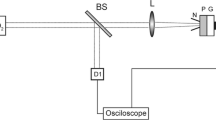Abstract
Hydrogen peroxide is a green propellant used in nanosatellites for micro-propulsion. The flow pattern and concentration of hydrogen peroxide decide the thrust produced in such micro-thrusters in which the thrust is of the order of milli-Newton. A mini/micro-fluidic cross-sectional geometry can dramatically vary the fluid flow characteristics, particularly for a capillary-driven flow in such devices. In the present work, experiments are carried out in a mini-square channel of 50 × 2 × 2 mm size and thickness of 0.5 mm with air–hydrogen peroxide as two-phase flow fluids. Bubble and slug flow regimes formed during the flow are recorded using a PROMON high-speed camera. An infrared transceiver circuit is used for identifying the flow regimes. COMSOL Multiphysics package is used to develop a numerical model. The developed numerical model is validated with the experiments by comparing the signal behaviour. The shape effects of the square, circular, and triangular channel on IR transceiver irradiation during two-phase flow are detailed. The effects of dimensional ratio of the test section on IR transceiver irradiation are discussed. The attenuation behaviour of the hydrogen peroxide fluid (6, 30, and 50% concentration) on IR transceiver irradiation during two-phase flow is presented.









Similar content being viewed by others
References
Azimi H, Shabanlou S (2015) The flow pattern in triangular channels along the side weir for subcritical flow regime. Flow Meas Instrum 46:170–178
Azimi H, Shabanlou S (2016) Comparison of subcritical and supercritical flow patterns within triangular channels along the side weir. International Journal of Nonlinear Sciences and Numerical Simulation 17(7–8):361–368
Barreto EX, Oliveira JLG, Passos JC (2015) Analysis of air-water flow pattern in parallel microchannels: a visualization study. Exp Therm Fluid Sci 63:1–8
COMSOL AB (2016) Ray optics module user’s guide pp. 92-93. COMSOL Multiphysics® v. 5.2a. COMSOL AB, Stockholm, Sweden
Dos Reis E, da Silva Cunha D (2014) Experimental study on different configurations of capacitive sensors for measuring the volumetric concentration in two-phase flows. Flow Meas Instrum 37:127–134
Greenfield B, Louisos W, Hitt D (2011) “Numerical simulations of multiphase flow in supersonic micro-nozzles”, 49th AIAA aerospace sciences meeting including the new horizons forum and aerospace exposition. Aerosp Sci Meet. https://doi.org/10.2514/6.2011-189
Jaine Tsai (2005a) technical Data sheet 5 mm infrared LED, T-1 3/4, Everlight Electron Co. LTD pp 1–7. http://www.everlight.com/file/ProductFile/201407061534026941.pdf
Jaine Tsai (2005b) Technical data sheet 5 mm silicon PIN photodiode, T-1 3/4, Everlight Electron. Co. LTD pp 1–7. http://static6.arrow.com/aropdfconversion/a2bc18f1ecf50b732261e5a5602cecc7e01b56f2/pd333-3b-h0-l2.pdf
Li J, Zhao J, Wang S (2013) Gas-liquid two-phase flow in a mini-square-channel with a permeable wall (influence of surface characteristics of a permeable wall). Int J Heat Mass Transf 66:90–100
Liu Y, Hansen A, Block E, Morrow NR, Squier J, Oakey J (2017) Two-phase displacements in microchannels of triangular cross-section. J Colloid Interface Sci 507:234–241
Mcdevitt MR, Hitt DL (2014) Numerical study of liquid phase hydrogen peroxide decomposition in catalytic micro–reactors. Proc Int Conf N Trends Transp Phenom 83:1–8
Mithran N, Muniyandi V (2019) IR Transceiver irradiation characteristics on bubble/slug flow regimes in conventional and minichannels. IEEE Trans Inst Meas 68(1):240–249
Mithran N, Venkatesan M (2017) Effect of IR Transceiver orientation on gas/liquid two-phase flow regimes. Flow Meas Instrum 58:12–20
Prasser HM, Bolesch C, Cramer K, Ito D, Papadopoulos P, Saxena A, Zboray R (2016) Bubbly, slug, and annular two-phase flow in tight-lattice subchannels. Nucl Eng Technol 48(4):847–858
Seinfeld JH, Pandis SN (2006) Atmospheric Chemistry and Physics, 2nd edn. Wiley, New Jersey
Seshadri A, Mahadevan S, Muniyandi V (2015) Measurement of liquid film thickness in air–water two phase flows in conventional and mini channels using image processing. Korean J Chem Eng 32(5):826–836
Shi Y, Wang M, Shen M (2016) Characterization of oil-water two-phase flow in a horizontal pipe with multi-electrode conductance sensor. J Pet Sci Eng 146(1985):584–590
Shrivignesh K, Suwathy R, Thirumalaikumaran SK, Venkatesan M (2016) Annular mixing section effects on hydrogen peroxide–air two-phase flow inside a mini-channel. Int J Energ Mat Chem Propuls 15(6):453–466
Thulasidas TC, Abraham MA, Cerro RL (1997) Flow patterns in liquid slugs during bubble-train flow inside capillaries. Chem Eng Sci 52(17):2947–2962
Triplett KA, Ghiaasiaan SM, Abdel-Khalik SI, Sadowski DL (1999) Gas–liquid two-phase flow in microchannels part I: two-phase flow patterns. Int J Multiph Flow 25(3):377–394
West W (2014) Absorption of electromagnetic radiation. McGraw-Hill Education, In Access Sci. https://doi.org/10.1036/1097-8542.001600
Widdis SJ, Asante K, Hitt DL, Cross MW, Varhue WJ, McDevitt MR (2013) A MEMS-based catalytic microreactor for a H2O2 monopropellant micropropulsion system. IEEE/ASME Trans Mechatron 18(4):1250–1258
Xu J, Cheng P, Zhao T (1999) Gas–liquid two-phase flow regimes in rectangular channels with mini/micro gaps. Int J Multiph Flow 25(3):411–432
Zhang M, Ming Pan L, Ju P, Yang X, Ishii M (2017) The mechanism of bubbly to slug flow regime transition in air-water two phase flow: A new transition criterion. Int J Heat and Mass Transf 108:1579–1590
Author information
Authors and Affiliations
Corresponding author
Additional information
Publisher's Note
Springer Nature remains neutral with regard to jurisdictional claims in published maps and institutional affiliations.
Rights and permissions
About this article
Cite this article
Mithran, N., Aafrin Sulthana, S. & Venkatesan, M. Attenuation and shape effects on IR transceiver irradiation behaviour during air–hydrogen peroxide two-phase flow. Chem. Pap. 73, 2783–2792 (2019). https://doi.org/10.1007/s11696-019-00831-9
Received:
Accepted:
Published:
Issue Date:
DOI: https://doi.org/10.1007/s11696-019-00831-9




